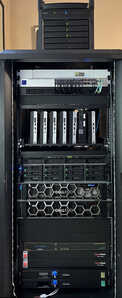Jeff's Mini Data Center - 2023
Stable since the beginning of the year, I proudly present my upscaled (and downscaled) mini datacenter.
Upscaled with the addition of a leased Dell PowerEdge R740 and another PowerEdge R750. Downscaled as the OptiPlex minitowers I had have been sold off. The PowerEdge R710 was long ago sold. The R720, then the T620, sold off. Patch panels and 6" multicolored network patch cables removed, and all Ethernet cables swapped out for Monoprice SlimRun Ethernet cables.
Equipment Details
On top of the rack:
-
Synology DS3615xs NAS connected via 25G fibre Ethernet, Linksys AC5400 Tri-Band Wireless Router. Mostly obscured: Arris TG1672G cable modem.
In the rack, from top to bottom:
-
Sophos XG-125 firewall
-
Ubiquiti Pro Aggregation switch (1G/10G/25G)
-
Brush panel
-
Shelf containing 4 x HP EliteDesk 800 G5 Core i7 10G Ethernet (these constitute an 8.0U1 ESA vSAN cluster), HP EliteDesk 800 G3 Core i7, HP OptiPlex 5070m Micro Core i7, HP EliteDesk 800 G3 Core i7 (these three systems make up a "remote" vSphere cluster, running ESXi 8.0U1). The Rack Solutions shelf slides out and contains the 7 power bricks for these units along with four Thunderbolt-to-10G Ethernet adapters for the vSAN cluster nodes.
-
Synology RS1619xs+ NAS with RX1217 expansion unit (16 bays total), connected via 25G fibre Ethernet
-
Dell EMC PowerEdge R740, Dual Silver Cascade Lake, 384GB RAM, BOSS, all solid state storage, 25G fibre Ethernet
-
Dell EMC PowerEdge R750 Dual Gold Ice Lake, 512GB RAM, BOSS-S2, all solid state storage (including U.2 NVMe RAID), 25G fibre Ethernet
-
Digital Loggers Universal Voltage Datacenter Smart Web-controlled PDU (not currently in use)
-
2 x CyberPower CPS1215RM Basic PDU
-
2 x CyberPower OR1500LCDRM1U 1500VA UPS
There's 10G connectivity to a couple of desktop machines and 25G connectivity between the two NASes and two PowerEdge servers. Compute and storage are separate, with PowerEdge local storage mostly unused. The environment is very stable, implemented for simplicity and ease of support. There's compute and storage capacity to deploy just about anything I might want to deploy. All the mini systems are manageable to some extent using vPro.
The two PowerEdge servers are clustered in vCenter, which presents them both to VMs as Cascade Lake machines using EVC, enabling vMotion between them. The R750 is powered off most of the time, saving power. (iDRAC alone uses 19 watts.) The machine can be powered on from vCenter or iDRAC.
Recently, I've switched from using the Digital Loggers smart PDU to Govee smart outlets that are controllable by phone app and voice/Alexa. One outlet with a 1-to-5 power cord connects the four vSAN cluster nodes and another connects the three ESXi "remote" cluster nodes.
"Alexa. Turn on vSAN."
"Alexa. Turn on remote cluster."
Two more smart outlets turn on the left and right power supplies for the PowerEdge R750 that's infrequently used.
"Alexa. Turn on Dell Left. Alexa. Turn on Dell Right."
Total storage here is about 6/10 petabyte.
There are a couple of additional NASes for, mostly, onsite media backup.
Okay, that's a fair bit of equipment. So what's running on it?
Software and Systems
Well, basically most of what we have running at the office, and what I support in my job, is running at home. There's a full Windows domain, including two domain controllers, two DNS servers and two DHCP servers.
This runs under a full vSphere environment: ESXi 8.0U2, linked vCenter Servers, vSphere Replication. SRM. Also, vSAN (ESA), some of the vRealize (now Aria) suite, including vRealize Operations Managment (vROps) and Log Insight. And... Horizon: Three Horizon pods, two of which are in a Cloud Pod federation, and one of which sits on vSAN. DEM and App Volumes also run on top of Horizon. I have a pair of Unified Access Gateways which allow outside access from any device to Windows 10 or Windows 11 desktops. Also running: Runecast for compliance, Veeam for backup, and CheckMK for monitoring.
Future plans include replacing the Sophos XG-125 firewall with a Protectli 4-port Vault running Sophos XG Home. This will unlock all the features of the Sophos software without incurring the $500+ annual software and support fee. I'm also planning to implement a load balancer ahead of two pairs of Horizon connection servers.
What else? There's a fairly large Plex server running on the DS3615xs. There's also a Docker container running on that NAS that hosts Tautulli for Plex statistics. There are two Ubuntu Server Docker host VMs in the environment (test and production), but the only things running on them right now are Portainer and Dashy. I lean more toward implementing things as virtual machines rather than containers. I have a couple of decades worth of bias on this.
So that's it. My little data center in Sheepshead Bay, Brooklyn.
I'd love to entertain any questions. Hit me up.


